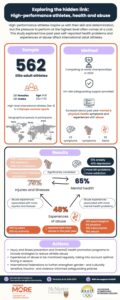Keywords: Athlete abuse, injuries, mental health, high-performance sport
“Olympic level sport takes more than just your daily dedication during practice hours. And when I say that I go beyond the obvious notion of dieting, resting, and even-meditating. What starts as a child’s dream ends up becoming not just something you do, but who you are: swimming was my identity, and ‘the medal’ my sole reason for existence. When you’re aiming at the Olympics you pay with life. Was it worth it? Some would argue that it was, some would even call it a sacrifice….”

Bruno Fratus, Olympic medallist (BRA)
High-performance athletes inspire us with their skill and determination, but the pressure to perform at the highest level often comes at a cost. This study explored how health problems and experiences of abuse affect high-performance adult athletes.
Why is this study important?
An athlete’s physical and mental health are both crucial for sport success, yet they are sometimes endangered by heavy training and competition load. Additionally, experiences of abuse are known to negatively impact health. Previous research on athlete abuse has focused mainly on childhood experiences, leaving a significant gap in our knowledge about adult athletes. This is a problem because the challenges don’t disappear when athletes grow older.
This study focusses on adult athletes competing at the highest international level and examines their experiences within the past year. It highlights not just the widespread nature of abuse in sports but also its impact on both physical and mental health.
How did the study go about this?
The study surveyed 562 elite athletes from four different Olympic summer sports, all competing in world championships between May and December 2023. Participants completed an anonymous online questionnaire that covered three key areas: physical health issues like injuries or illnesses, mental health symptoms such as anxiety or depression, and their experiences with abuse over the past 12 months. Upon analysis of the data, we uncovered important connections between health problems and experiences of abuse, while also identifying differences between male and female athletes.
What did the study find?
The study revealed that over the past year, a large majority of athletes experienced health problems. About 75% of athletes reported at least one physical health problem, with fatigue, headaches, and musculoskeletal injuries being the most common. In addition, 65% reported symptoms of mental health issues, with anxiety and depression topping the list. Female athletes were more likely than male athletes to report both physical and mental health problems. Addiction-related issues, however, were more frequently reported by male athletes.
Experiences of abuse were also widespread in this adult athlete sample, both from peer athletes as well as authority figures, such as coaches. Over half of the female athletes (53%) and 42% of the male athletes said they had experienced some form of abuse in the past year. Psychological abuse was the most common form, followed by instrumental abuse, where athletes experienced abuse intended to increase their performance.
Importantly, the study found that athletes who experienced abuse were more likely to report both physical and mental health problems. Psychological and instrumental abuse were associated with both physical and mental health issues, while sexual violence was primarily linked to mental health challenges. These findings emphasize that the impact of abuse in sports extends far beyond the immediate experience, affecting athletes’ overall well-being and performance.
What are the key take-home points?
The study underscores the strong connection between physical and mental health in elite athletes. Those who experienced injuries or illnesses were more likely to report mental health struggles, and vice versa. This highlights the need for a holistic approach to athlete care that addresses both physical and mental well-being.
The research also demonstrates the pervasive nature of abuse in high-performance sports. Experiences of abuse, whether psychological, neglect, physical, or sexual, are alarmingly common among these adult athletes. Female athletes, in particular, face greater challenges, reporting higher rates of health problems and abuse than their male counterparts.
Addressing these issues requires coordinated efforts from sports organizations, (para-) medical professionals, and researchers. Sports organizations must continuously improve policies to prevent abuse, create safer environments, and offer better support for affected athletes. Medical professionals should include screening questions for potential experiences of abuse when treating athletes for injuries or mental health concerns.
The findings also highlight the need for more research into the links between health and abuse. By installing health and abuse surveillance mechanisms, sports stakeholders can more fully understand these connections and design better prevention, response, remedy, and support systems.
Moving forward
This study shines a light on the hidden struggles of high-performance adult athletes, showing that their physical and mental health are deeply connected and often influenced by experiences of abuse. These findings call for urgent action to create safer environments in sports and provide comprehensive care for athletes.
High-performance athletes may seem invincible when performing on the world stage, but their health and well-being require as much attention as their training and performance. By addressing these challenges, we can ensure they not only excel in their sport but also lead healthier, more fulfilling lives.

Blog authors: Tine Vertommen and Margo Mountjoy
Infographic design: Tine Vertommen and Helena Verhelle
Reference
Read the full paper here: https://bjsm.bmj.com/content/58/22/1360